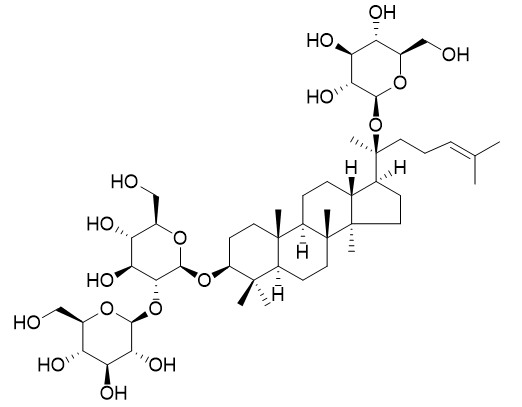Vinaginsenoside R3
Reference standards.
Inquire / Order:
manager@chemfaces.com
Technical Inquiries:
service@chemfaces.com
Tel:
+86-27-84237783
Fax:
+86-27-84254680
Address:
1 Building, No. 83, CheCheng Rd., Wuhan Economic and Technological Development Zone, Wuhan, Hubei 430056, PRC
Providing storage is as stated on the product vial and the vial is kept tightly sealed, the product can be stored for up to
24 months(2-8C).
Wherever possible, you should prepare and use solutions on the same day. However, if you need to make up stock solutions in advance, we recommend that you store the solution as aliquots in tightly sealed vials at -20C. Generally, these will be useable for up to two weeks. Before use, and prior to opening the vial we recommend that you allow your product to equilibrate to room temperature for at least 1 hour.
Need more advice on solubility, usage and handling? Please email to: service@chemfaces.com
The packaging of the product may have turned upside down during transportation, resulting in the natural compounds adhering to the neck or cap of the vial. take the vial out of its packaging and gently shake to let the compounds fall to the bottom of the vial. for liquid products, centrifuge at 200-500 RPM to gather the liquid at the bottom of the vial. try to avoid loss or contamination during handling.
Chinese Journal of Hospital Pharmacy2020, 40(7)
Pharmacognosy Journal2019, 11(2): 369-373
Applied Biological Chemistry2022, 65(12)
Hum. Ecol. Res.2025, 63(2):165-174
Horticulture Research2022, uhac276.
J Inflamm Res.2022, 15:5347-5359.
Reprod Toxicol.2020, 96:1-10.
Mol Biol Rep.2024, 51(1):117.
Food Funct.2021, 12(4):1469-1481.
Appl. Sci.2022, 12(4), 2032.
Related and Featured Products
Chem Pharm Bull (Tokyo). 1994 Jan;42(1):115-22.
Saponins from Vietnamese Ginseng, Panax vietnamensis HA et Grushv. Collected in central Vietnam. II.[Pubmed:
8124758]
METHODS AND RESULTS:
Further investigation on the saponin composition of rhizomes and roots of Panax vietnamensis HA et GRUSHV. has resulted in the isolation and structural elucidation of seven new dammarane saponins named Vinaginsenoside R3 (12), Vinaginsenoside R4 (11), vinaginsenoside R5 (16), vinaginsenoside R6 (17), vinaginsenoside R7 (6), vinaginsenoside R8 (20), vinaginsenoside R9 (22), together with the identification of six known saponins including 20-gluco-ginsenoside-Rf (10), ginsenoside-Rc (4), notoginsenoside-R6 (9), quinquenoside-R1 (5), gypenoside XVII (2) and majoroside F1 (21).
The structures of the novel saponins were established on the basis of chemical and spectral evidence.
CONCLUSIONS:
Vina-ginsenoside-R3 is the first naturally occurring glycoside of dammarenediol II, while vina-ginsenosides-R5 and -R6, two ocotillol-type saponins, are two other examples of saponins having the rare alpha-glucosyl linkage.



